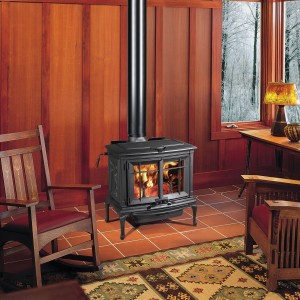Knowing the Basics & Know Your Options
According to the laws of physics, heat is transferred by three methods: convection, radiation and conduction. The transfer of heat from
one area to another by circulating air is called Convection. Movement of infrared electromagnetic rays through air without any warming
of the air but warming of any objects when the rays of light hit them is called Radiation. Sunlight is an excellent example of radiant
heat. Conduction is the transfer of heat along a solid object.
1) Choose your material:
Steel: Steel stoves heat up rapidly, utilizing convective heat. They also cool
down quickly when they are turned off. These stoves are often less expensive
than cast iron and soapstone. Additionally they produce the highest surface
temperature of all three materials.
Cast Iron: Cast iron stoves utilize radiant heat to warm up surfaces, furniture,
floors and walls. Cast iron stoves will often have decorative castings that
resemble a piece of furniture.
Soap Stone: Soapstone is a naturally occurring stone, made up mostly by
Talc, among other minerals. Although it is the most expensive of the
materials, it has superior heat retention, utilizing the conducive heat transfer
method. Wood stoves constructed with thick soapstone consist of a firebox
with polished exterior pieces and retain heat for hours, even after the fire is
extinguished.
All wood stoves will only achieve highest performance with correct operation and regular maintenance including annual professional chimney cleanings.
2) Firebox Size:
Firebox size is based on the amount of wood an appliance can hold. Firebox size also determines the heating capacity
of your stove. The larger the firebox, the higher amount of heat output the appliance is capable of producing.
3) Combustor Type:
You can expect all catalytic appliances across manufacturers to operate with the same efficiency and similarly
you can expect all non-catalytic appliances across manufacturers to operate with same efficiency.
Catalytic: The purpose of the catalyst is to lower the ignition temperature of the smoke so it will turn into
useable heat and reduce emissions. Usually smoke will ignite around 1100 degrees. The catalyst will lower the
ignition temperature to approximately 500-550 degrees by passing the smoke through a ceramic honeycomb
coated with either platinum or palladium. Essentially what this means that catalytic wood stoves will burn with
less oxygen allowing longer burn times, achieving an almost-ideal overnight burn. Even as the fire slows down
and the firebox temperature drops the catalyst will still utilize the smoke and retain the heat. Ideal for those
who wish to replace a major portion of their heating needs with their wood stove, this appliance offers higher
efficiency heating.
Non-catalytic: Non-catalytic wood stoves are slightly more affordable than catalytic stoves and require less maintenance. Since they
are based on an air-injection method, burn times will be slightly shorter than catalytic wood stoves. However, since non-catalytic
wood stoves require no other major components, operation is pretty straightforward.
Hybrid: Utilizes both catalytic and non-catalytic technology to achieve the most efficient burn possible.
4) Appliance door loading options:
Steel — loaded from front
Cast Iron — loaded from front, side or top
Soapstone — loaded from front or side
